A tactical engine building and combat game for 1-4 players
30 min per player
Designed by: Brent and Jillian Keath
Published by: Flannel Games
Furtherance feels a bit like an old school video game where you go about your business collecting items, researching technologies, advancing your knowledge/skills, and gearing up to go battle the big boss to allow your kingdom to prosper for years to come. Except the boss is your wife sitting across the table from you (truer words have never been said).
There are a few things in this game that didn’t work great for us, but the gameplay is interesting and challenging. Overall it was a solid first release for new publisher Flannel Games.
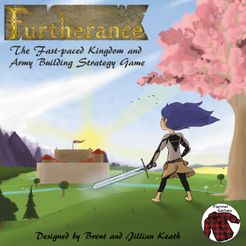
Gameplay Overview*
*This is not a comprehensive how-to-play, but a general overview to give context to the review
In Furtherance, 1-4 kingdom rulers set out to defeat the other kingdoms by recruiting units, constructing buildings, researching technologies, and attacking enemy castles. At the beginning of the game players choose a castle color, get one worker, four gold, and draft a leader. Each leader has a special ability that offers benefits or other advantages to the player.
Each turn follows this format:
1. Reset turned worker cards
2. Perform Worker Action(s)
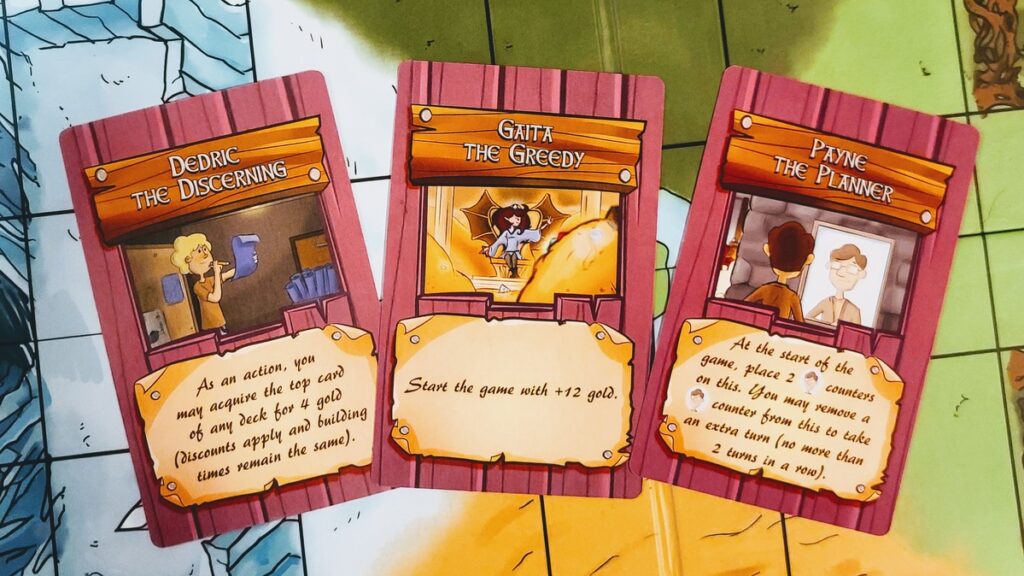
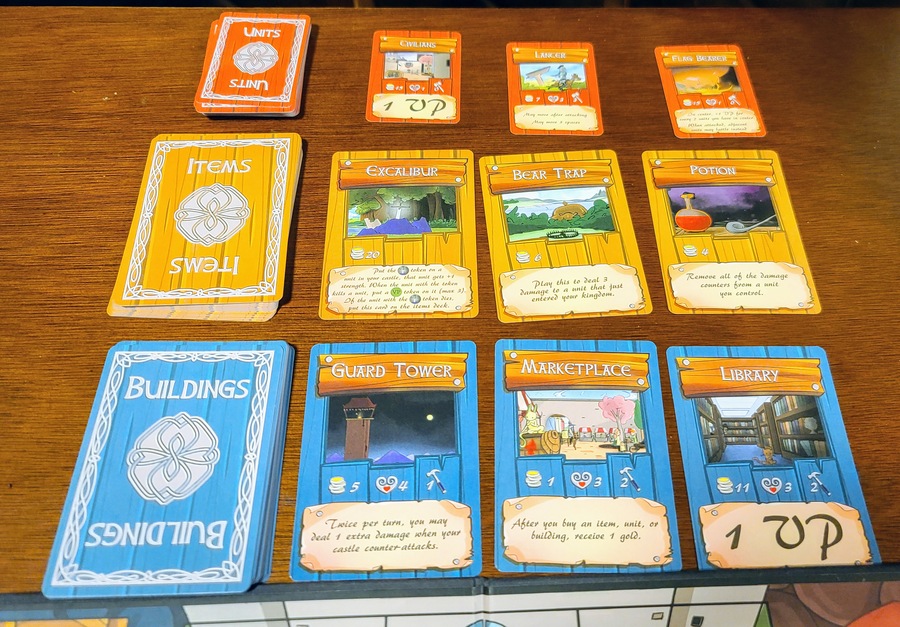
In a typical game, you will only have 1 worker, and therefore only 1 worker action per turn (even after upgrading). When you reach 4 points you get an additional worker.
Note: There is an optional beginner variant where you can choose to play with 2 workers and thus have 2 worker actions per turn from the beginning. We played with both 2 workers and 1 and found that in a 2-player game it’s a lot more fun to have 2 workers. More on that in a minute.
- Mine: collect 4 gold
- Market: Purchase up to 2 item cards
- One time use cards with special benefits
- Build: Start construction of a building
- Place associated number of hammer counters on building
- Develop: Remove one hammer counter from building or upgrade
- Recruit: Purchase a unit card
- Research: Look at the top 3 cards of a deck
- Put 1 card into personal research pile (limit 2)
- Return 1 card to the bottom of the deck
- Return 1 card to the top of the deck
- Upgrade: Draw 2 upgraded workers, keep one
- Place 3 hammer counters on upgrade card
- Replace worker with upgraded worker once hammers are removed
3. Move and Attack
- Units can move up to 2 spaces and attack twice
- Can attack units, buildings, or castles
- Units cannot move or attack on the turn they are recruited
The game ends when either 1 player earns 6 VPs or every other player is eliminated once their castle is defeated.
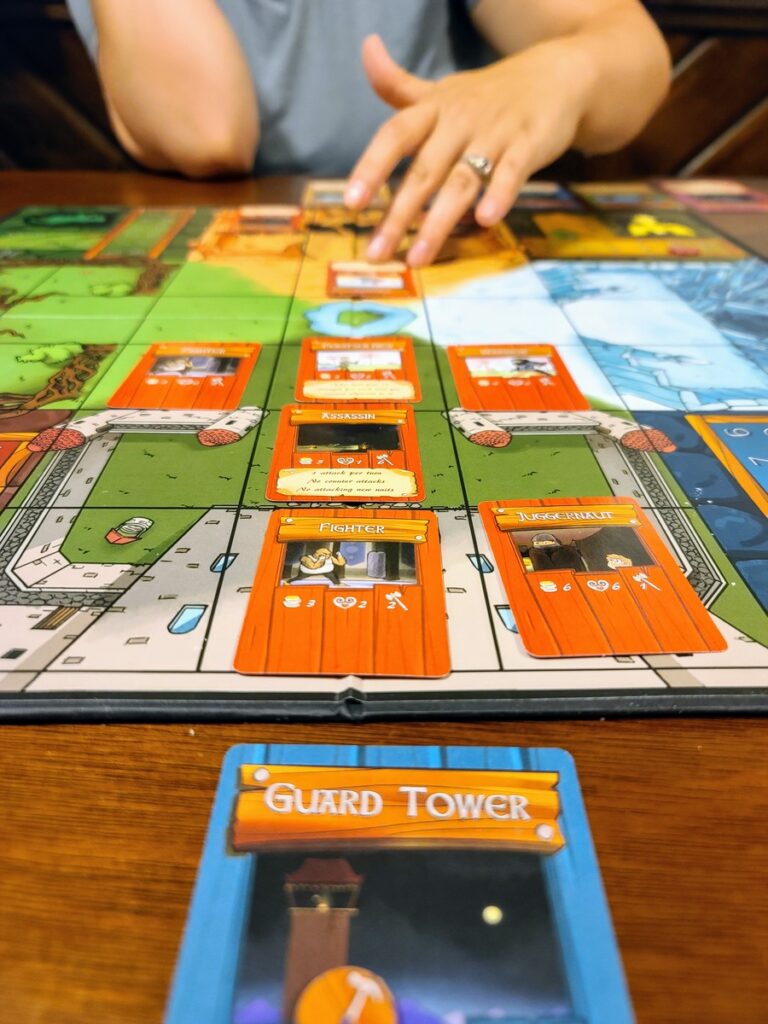
What do we think?
This is a solid first game from a new publisher. It’s not really our favorite type of game, and we had some trouble with a few elements, but overall it is a nice tactics game. At first glance, we thought this was relatively straightforward, and from a rules perspective, it is! But then when we started playing, we realized there was quite a bit of depth.
The publishers call this a “tactical engine building game” and it is definitely a combination of war tactics and engine building. Successful players are the ones who figure out how to balance building their engine while also reacting to their opponents.
Our first time playing through this game 2-player we both took completely the wrong approach (in hindsight). Because the first several turns of the game by design must focus on engine building, we both struggled to figure out when to start recruiting units vs. focusing on other areas. The real trick is keeping your strategy flexible by paying close attention to what your opponents are doing and reacting quickly. This is not a game where you can lose yourself in your engine building or rigidly stick to your plan.
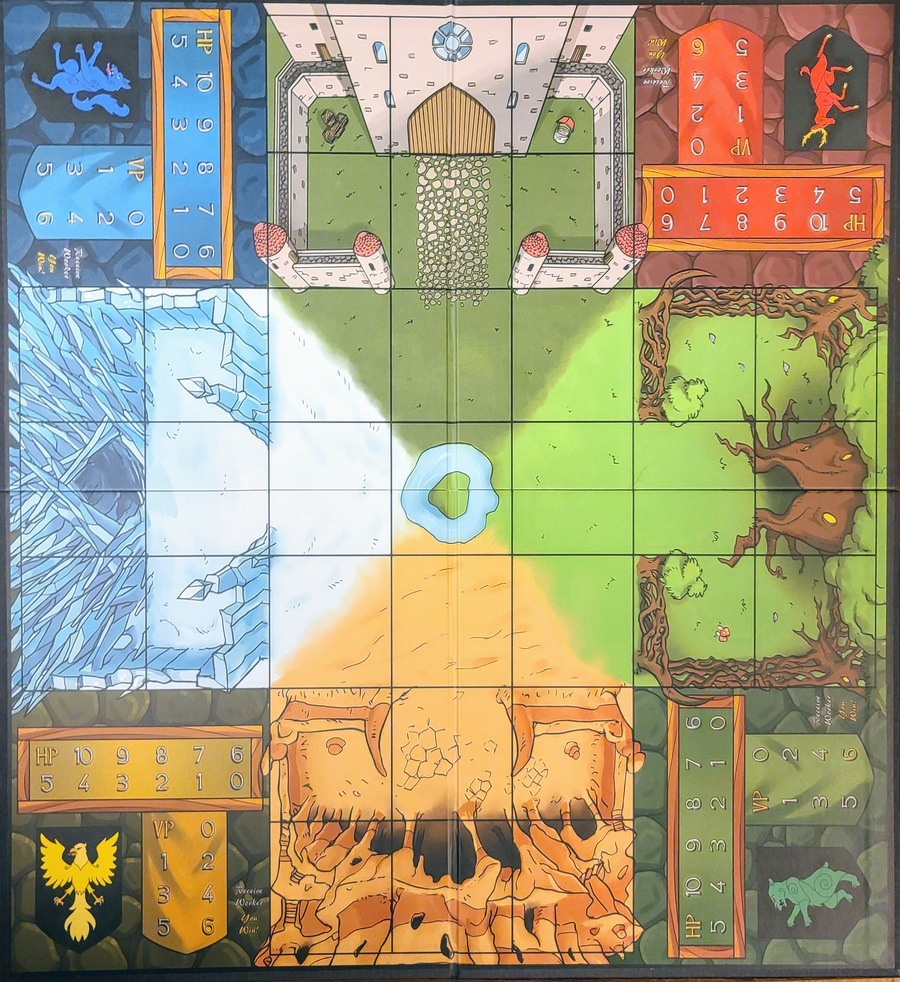
While we did enjoy this game, we found it had several drawbacks. The artwork is not our favorite, and the font on the cards was stylized in a way that was hard to read from across the table. Because there’s a marketplace tableau and each card has a lot of text, this did impact our enjoyment of the game.
One issue was partially solved by always playing an adaptation of what the rulebook dubs the “beginner” variant. We mentioned above that the “beginner” variant has players start the game with 2 workers, while the “advanced” only has one. For a 2-player game, having 2 workers from the start was essential to good pacing. Only having one action per turn in the beginning of a standard (advanced) game makes the game start out VERY slow. The “mining” action only gives 4 coins, whereas many of the cards you can buy to get a money engine going are 7+ coins, so spending 2 entire turns in a row just getting coins, then spending more turns taking off the hammers (“develop” action) was tedious. Starting with 2 workers speeds the beginning up and lets players get to the fun part much faster and we didn’t find that it changed the later game too much. We wouldn’t play a 2-player game without 2 workers again.
Pro Tip: do not underestimate the importance of research in the beginning of the game. Being able to find the right cards that improve your engine early on is critical.
Our last complaint was the pacing. Even with adding a second worker, the game was a bit slow and had moments where it felt like the game wasn’t moving forward or like it was stalled. In our opinion, it’s a medium-light game as far as complexity due to the pretty clear “next steps” available based on the available cards and the strategy set by your leader. For that genre it’s tough for us to justify an hour+ game.
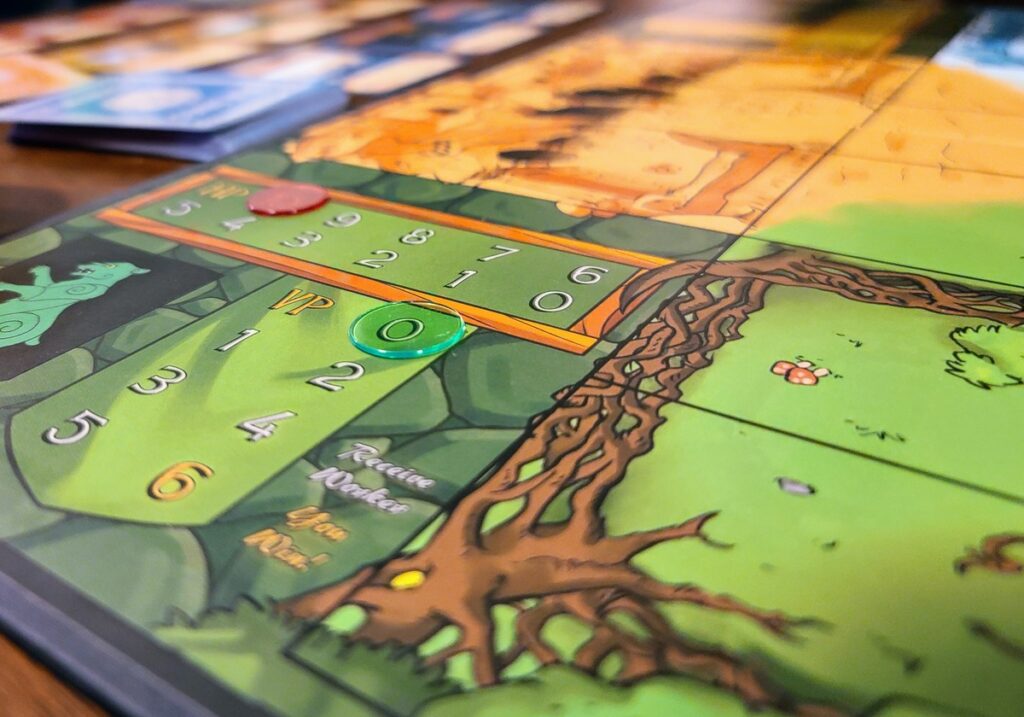
Now for the good stuff. This is definitely a tactical game at heart, your strategy and the “feel” of a game are going to depend heavily on what your opponents are doing. If they are focused on building up their units, you have to make sure you don’t ignore your defenses or you will be destroyed (Sarah found this out the hard way). Instead, we found a typical game to have a lot of give-and-take, where players trade off being the aggressor as they build/destroy units.
As a reminder, there are 2 ways to win – destroy all opponents’ castles, or score 6 VP. In a 2-player game, we found combat is not the best way to win – that’s just how you keep your opponent on their toes. It was much easier to win through getting to the 6VP first vs. destroying the other castle, and that’s mainly because the tactical aspect of the game is a lot of effort for the payoff. We both ended up adopting a solid defensive strategy with just enough offense and chaining cards together to keep the other player alert, but then heavily focus on getting VPs through buildings.
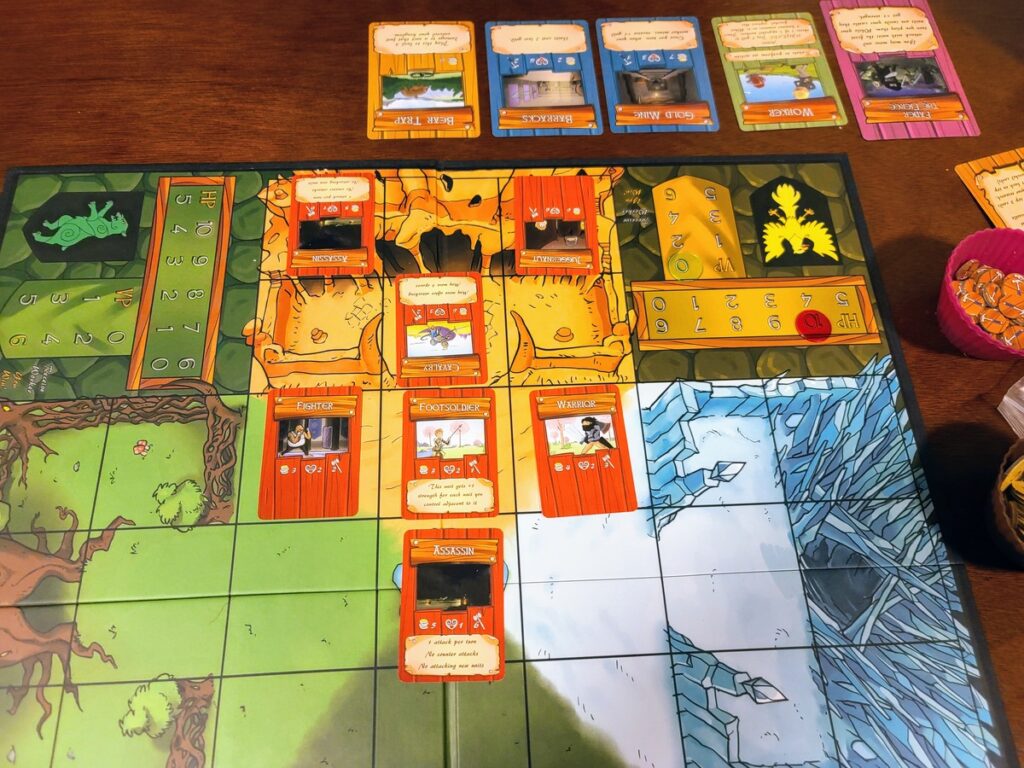
The card abilities are pretty neat. There are different strategic directions to take with the cards, especially the leaders who really set your strategy for each game. When paired together the leader abilities, building cards, and upgrades can get a satisfying engine going. A lot of the abilities are just neat and add interest to the game.
Unit cards, while not necessarily part of the engine, can combo up and pair well together, for example units that allow damage to be directed at adjacent units with better HP. We do wish there was a different way to mark which units belong to which castles other than just the direction they’re facing. In a 2-player game it wasn’t that big of a deal, but it would have enhanced the experience to have player markers.
Sarah's Take
Furtherance is an interesting game. It took me a game to wrap my head around needing to let my leader guide my strategy, rather than just doing the status quo of what I would do in any other engine building game. Once I figured that out, I was able to create really satisfying engines…maybe a bit to my determinant. I LOVE engine building games and have a tendency to over-focus on them allowing Emily to come in and wallop my castle with the array of units she built up. Important reminder: this is a tactical game more so than a strategic game.
Emily's Take
There are a few different strategies to try out and I like that I had to adapt my strategy to my leader and the cards that appeared.
I didn’t love the combat part of this game. Except for the game where Sarah completely ignored combat and I absolutely destroyed her, it seemed to me that the back-and-forth of combat was us just sort of killing each other off, then adding units, then killing them off, then adding them without actually accomplishing much.
The cards themselves were pretty cool and I thought the abilities were clever and fun to chain together. I also like games where I have to adapt my strategy turn-by-turn to the other player and to what’s available to me.
First Play
Our first play, we played the beginner variant with two workers and only to 4 points. This is our preferred way to play since it keeps the game going at a nice clip. On the first play, we definitely over-focused on the engine building and it took a while to realize that we weren’t going to get finely tuned engines going while neglecting combat, which speaks more to our personal typical strategy than the game 🙂
Rulebook
The rulebook is laid out well and there are plenty of examples along the way. There were a few (what we considered) minor rule omissions or necessary clarifications in the rulebook that were covered by the FAQs on BGG, mainly around combat. Some of the cards had ambiguous wording as well that raised questions about what they actually did, but those were mostly minor issues that didn’t impact gameplay.
Subsequent Plays
It took us a game or so to realize the flexibility this game requires. You have to be extremely mindful of what your opponent is doing and react to that in nearly an identical way. Sarah learned the hard way that trying to rush getting VP generating buildings while Emily built up a nice sized army to advance on her castle was NOT the way to play Furtherance. Playing this game several times was definitely necessary to get an accurate feel for it.
Play Time, Best Number of Players
We have only played this at 2 players and it works well as long as you know that emphasis has to be on tactical play. We suspect that 4 players may allow for a little more strategic planning and less reactive tactics. Play time felt a little longer than the box stated 30 min/player. 45 min/player seems more accurate for us with 1 worker/player, including set up and clean up. We think this game would be better suited for more than 2 players, but we didn’t get the chance to try it out (pandemics ruining game nights everywhere).
Parent Perspective
Furtherance is really friendly to interruptions due to its tactical nature and relatively low complexity for the type of game. As seems to be a frequent occurrence Rowan needed approximately 800 different things each time he came out of his room after bedtime when we were playing and neither of us felt like we lost our train of thought during the interruptions.
Neither set up nor clean up are overly involved so it’s reasonable for one person to set the game up while the other puts the kiddos to bed…or gets ice cream while clean up happens 🙂
Our problem as parents is that this game is really long for the level of complexity. Our free time to game together is very limited, so if we want to play an hour+ game, our personal preference would be for a heavier game.
Who would like it?
This game has both tactics and engine building, but we’d say the people who will like it most would be the ones who love combat and head-to-head tactical games. Furtherance has a low barrier to entry and cool engine building, but if you don’t like the combat this won’t be as fun.
Overall Rating
5/10: Average
*See our rating scale HERE
This was a tough one for us to rate. The game itself was okay and we definitely think it will have an audience among people looking for a medium-ish weight tactical game. Our biggest issue was that in the grand scheme of similar weight games that we like, it wasn’t quite as fun for us. If a game has an important combat mechanism we want it to feel like the combat is able to push the game forward more than we were able to in this game (conquering, racking up points, gaining resources, etc). The pacing issue was partially fixed by always using 2 workers, so we’d always play it that way. Overall, it’s a solid game and a great start for Flannel Games.
Click through for more posts, or follow us to see what we’re playing and for new post updates!
